Do dogs understand affection from humans even if they can’t speak our language?
As a dog trainer, I have met thousands of dog owners whose eyes yearn to be told that yes, dogs can understand humans.
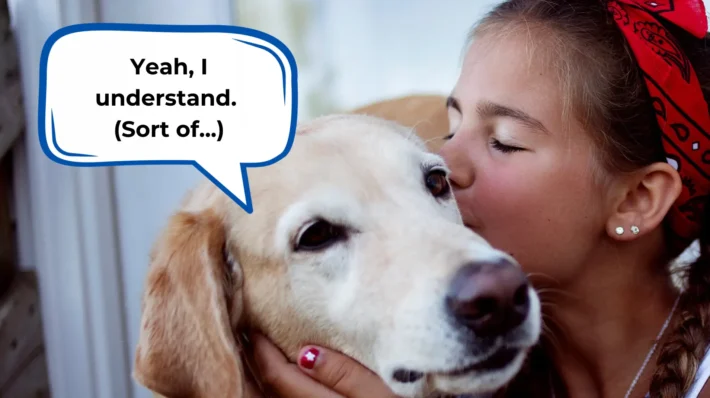
Dogs don’t speak English, so it’s always a question of whether dogs can truly understand the hugs, or the “I love you!” expressions.
Here’s the good news, dog lovers: YES, they understand us! But dogs understand humans differently.
It’s amazing.
But this beautiful realization also comes with a big responsibility.
Hi, I'm Doggy Dan… read on to learn more.
Key Takeaways
- Dogs do not have an automatic understanding of the human language, but they use observation to decipher what we mean. You show your dog affection through your energy and actions.
- Can dogs understand humans? Our pets have an innate ability to sense and take on energy.
- As dog owners, we are the ones that are always with our dogs. Because they take on energy, we have to also make sure we keep our emotions and energies in check.
Table of Contents
Can Dogs Understand Humans: The Story of Buster
Buster's story holds a golden lesson because it vividly illustrates the incredible understanding and emotional connection dogs have with their humans.
(Watch the video below for Buster’s story.)
It also is a great story to answer the question “Can dogs understand humans?”
In this particular case, Buster's owner was enduring a tremendously difficult period in her marriage. She confided in me about the mistreatment she and her dog endured at the hands of her husband.
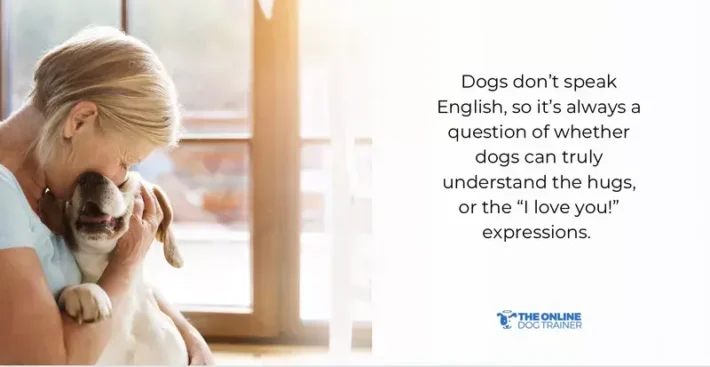
Throughout the prolonged ordeal, Buster was a silent witness, absorbing all the negative energy and emotions swirling around him.
But one day, when his owner finally decided that enough was enough and it was time to walk away, Buster seized the opportunity to convey a powerful message to her husband.
In a deliberate move, Buster headed toward the area where the husband was engrossed in watching something on the TV.
THIS FREE WEBINAR WILL HELP YOU UNDERSTAND DOG COMMUNICATION BETTERWith a determined gaze, he positioned himself directly in front of the screen and, to everyone's surprise, left a sizable poo behind.
Now, I can only speculate, but it seems clear that Buster's gesture was his way of declaring, “We're finished here. This is my parting gift.”

Throughout the difficult journey, he had been attentively observing everything, and this was his final act to communicate his unwavering support for his owner and his disapproval of the husband's actions.
Buster's memorable action serves as a powerful reminder of the depth of understanding and empathy that dogs possess.
They have an uncanny ability to perceive and respond to our emotions, even in the most challenging circumstances.
In this case, Buster's poignant message conveyed not only his loyalty but also his unwavering support for his owner, leaving an indelible mark on their shared journey.
Can Dogs Understand Humans: Can Dogs Understand English?
Whenever I tell people about the story of Buster, I’m often asked:
“So, Doggy Dan, does it mean that dogs understand our language?”
Apart from the question of whether dogs can understand humans, I’m also frequently asked if dogs get the English language. Or just about any other language!

A quick answer is this: no. Understanding human language for dogs isn’t a natural talent, but instead a skill developed by constant observation.
How Dogs Understand Words
Dogs are amazing with familiarizing with words, including intonations and tone. The understanding of dogs is shaped not only by what we say but also by how we say it.
FREE WEBINAR ON DEALING WITH A REACTIVE DOG WITHOUT THE STRESSIn their quest to understand humans, dogs skillfully interpret both human spoken language and body language.
Just like in Buster’s case, the dog knew that the household was on high stress probably because of the shouting, the arguing, and the fear of his owner.
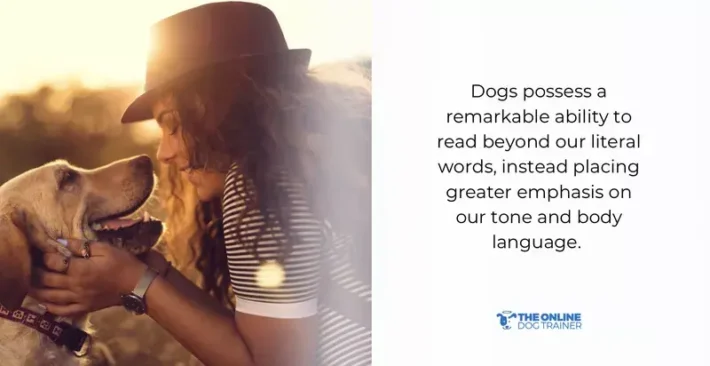
Dogs possess a remarkable ability to read beyond our literal words, instead placing greater emphasis on our tone and body language.
When trying to understand human words and body language, they attentively focus on us, keenly observing our physical cues.
They carefully analyze our facial expressions, posture, and body movements, while also listening intently to the tone of our voice.
By combining these various observations, dogs form a comprehensive understanding of our meaning and desires. And then they get us!
Do Dogs Understand Affection, Hugs, and Kisses from Humans?
What does your dog feel when you nuzzle them close? When you hold them and give them kisses?
Dr. Brian Hare, a canine cognition expert, confirms that dogs mentally understand human affection.
In fact, dogs have the ability to boost our oxytocin levels — just like what happens when parents and babies interact with each other — and vice versa.
Dog Love: What Dogs Feel When You Hug Them
It’s a popular notion that dogs don’t like hugs because they feel uncomfortable with a human’s grip.
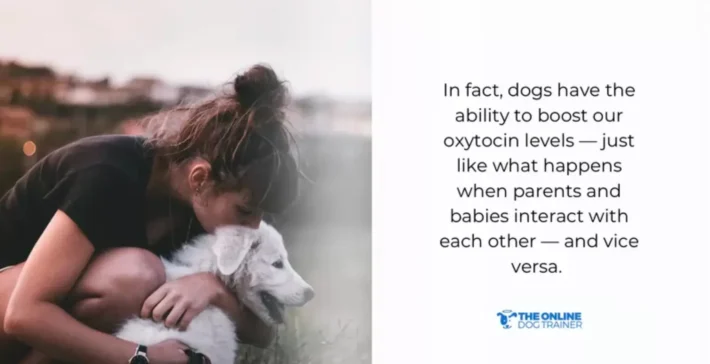
However, I believe that each dog is unique, and some dogs really love the cuddles and snuggles!
I would just like to emphasize that dogs respond to the energy that comes with a hug.
Additionally, if our hug feels safe, comforting, and respectful of their boundaries, our dogs can respond positively to a hug.
However, if a hug comes with a lot of force or if a hug persists despite our dogs’ resistance, the affection can be perceived negatively.
What Do Dogs Feel When You Kiss Them
Kisses are powerful… especially in conveying love for our dogs. Here are three things that a kiss can communicate to dogs.
Affection and Love
Dogs are highly social animals and form strong emotional bonds with their human companions.
A kiss, for a dog's brain, means love and affection.
Most dogs can feel the warmth and tenderness conveyed through the physical contact, which reinforces the bond between dog and owner, and strengthens their feelings of security and attachment.
Comfort and Reassurance
Kissing your dog can provide a sense of comfort and reassurance.
The physical contact, combined with your soothing voice and gentle touch, can help alleviate any anxiety or stress they may be experiencing.
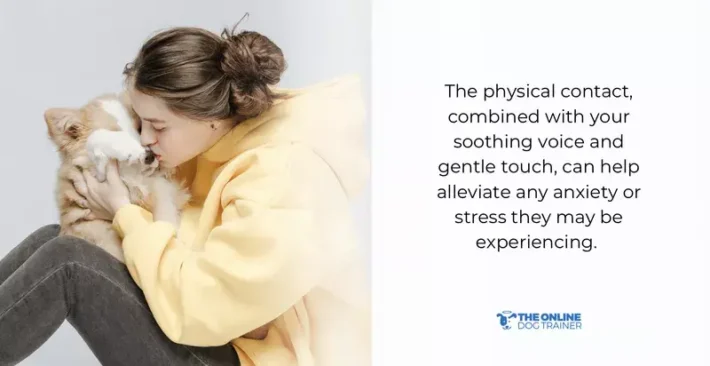
It reassures them that they are loved and cared for, promoting a sense of well-being and contentment.
Positive Reinforcement
Dogs are highly responsive to positive reinforcement, and kisses can serve as a form of reward or praise.
When you kiss your dog, they may interpret it as a signal that they have done something right or have pleased you in some way.
This positive reinforcement can strengthen their confidence and encourage desired behaviors, fostering a harmonious relationship between you and your furry friend.
Can Dogs Understand Humans: How Dogs Feel Their Owners’ Happiness, Sadness, Grief, Fear
Buster’s story always lights a bulb to people who hear it.
“Doggy Dan, it simply means dogs can understand human emotions!”
Just like understanding human language, perceiving human emotion takes a lot of processing for dogs. But they can. Like what Buster demonstrated, dogs can understand the human emotions of their pet owners.
Dogs and humans share the ability to form a special neural connection by activating the human oxytocin bonding pathway, a mechanism identical to the one used by parents and infants. This is triggered by mutual gazing or physical contact like petting, which causes oxytocin levels to increase in both species.
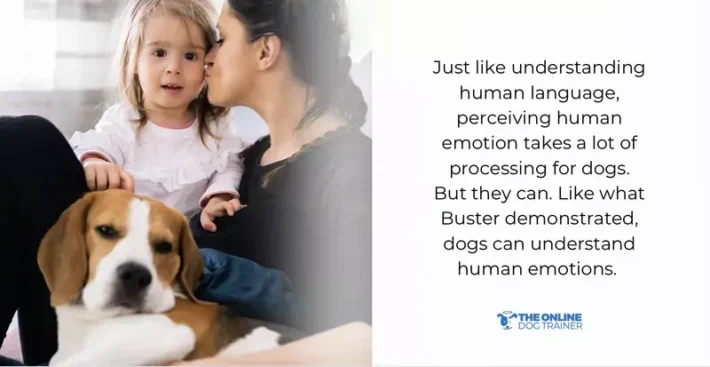
How do they do it? Here are five ways that dogs process human emotions.
Dogs Understand Humans Through Emotional Mirroring
Dogs have an incredible ability to sense and mirror the emotions of their owners
When we are happy, they often respond with wagging tails, playful behavior, and an overall joyful demeanor.
Similarly, when we are sad or upset, they may show concern, offer comforting gestures, or simply stay close by our side.
Empathetic Companionship
Dogs are highly empathetic creatures.
Your beloved pet can pick up on subtle cues, such as changes in our tone of voice, body language, or facial expressions.
When we are feeling down or experiencing grief, dogs often provide comforting companionship by staying close, offering gentle nudges, or even resting their head on our lap.
Here are a few ways your dog shows they understand you.
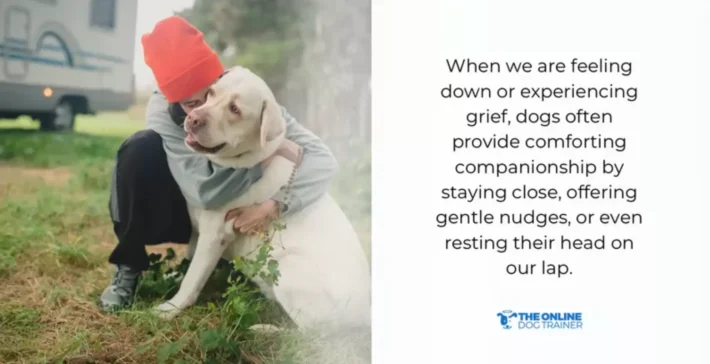
Dogs Understand Humans Through Sensitivity to Energy
Dogs are incredibly attuned to the energy and atmosphere around them.
They can sense when we are feeling anxious, fearful, or stressed. They can observe our conversations and the differences in how we react, or how the energy is.
And our energy sends a strong message to our furry companions exactly how we feel! In fact, how you feel eventually shows in how your dog acts. When you're calm, they show a relaxed posture. When you're stressed, they can be restless. Our dogs are incredibly perceptive!
Discover the powerful, force-free method that’s helped over 100,000 dog owners finally fix reactivity—without treats, tricks, or yelling.
Dogs Feel Emotions Through Behavioral Changes
Dogs are keen observers of human behavior, so they can detect changes in our routines, habits, and emotional states.
When we are feeling fearful, dogs may become more alert and vigilant, displaying protective behaviors. Conversely, when we are happy and relaxed, they may mirror our moods and engage in playful antics.
Observing Our Presence
Dogs can understand humans and emotions through simply observing us, so we don’t need to talk. Or directly say things to our dogs.
They notice our emotional cues — how we react, how differently we behave, and even how we treat people. That’s how observant they are, so it’s no surprise they can get us fast.
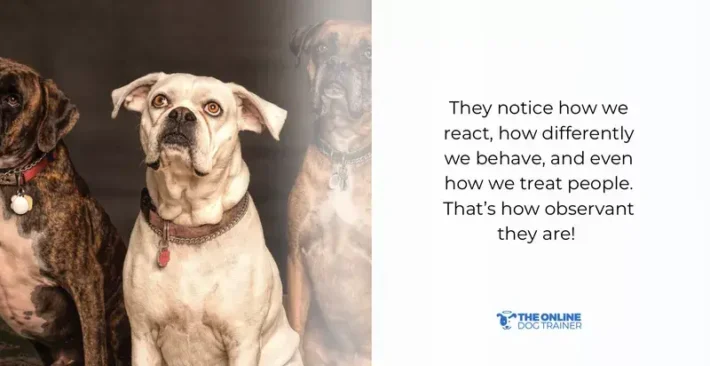
Tears never go unnoticed. Most of the time, these observations are mirrored.
We can tell that they get us when they also mirror our behavior.
The beauty in this is they also have an innate ability to offer emotional support to their owners during challenging times. They can provide a nonjudgmental presence, lending a listening ear (or attentive ear, in this case) when we need it most.
Their unwavering loyalty and unconditional love can be a source of comfort and solace, helping us navigate through feelings of sadness, grief, or fear.
Do Dogs See Us as Leaders or Parents?
In my best-selling course, the Dog Calming Code™️, I emphasize over and over again that dogs see everything in pack-mentality.
Dogs do not have the solid concept of family, but they would either see us as a member of the pack to protect, or the leader to follow.
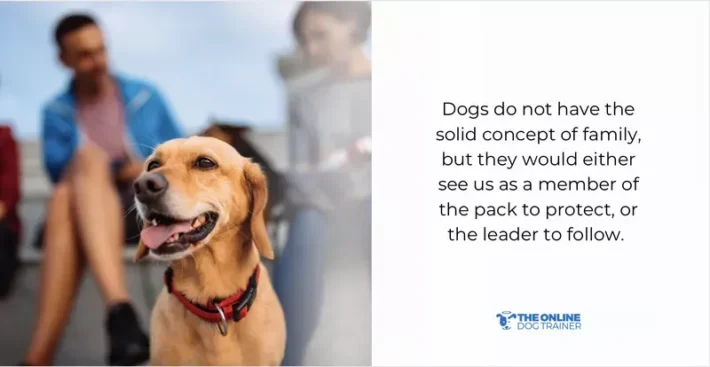
In the eyes of an untrained dog, we are part of the pack that they need to protect. When this is etched in our dog’s mind, our pets become frantic in ensuring we’re safe 100% of the time.
This frantic desire to protect is exhibited in restlessness, constant anxiety and stress, and — in most cases — a dog’s refusal to listen to you.
Dogs Need to See Us As the Leader of the Pack
One of my training foundations in my years as a dog trainer is to first help dog owners establish themselves as the leaders that their dogs can trust, respect, and rely on.
By assuming the role of a strong leader, we instill a sense of security and structure within the pack dynamic. And then dogs can start understanding humans.
Dogs thrive in an environment where they have a clear understanding of their position within the hierarchy.
This clarity enables them to relax, focus, and be more receptive to our guidance.
They start to relax and stop being on constant alert. Your dog starts to realize that’s your job, not theirs (this is where the naughty behaviors subside).
Our pets recognize that we have their best interests at heart, and this trust forms the foundation for effective communication and a harmonious relationship.
Can a Pack Leader Become Affectionate to Dogs?
“Doggy Dan, if I want to be a leader in the eyes of my dog, can I still be affectionate to them?”
Yes, a pack leader can absolutely be affectionate towards their dogs.

In fact, expressing affection is an important aspect of building a strong bond and trust between a dog and their leader.
While being a pack leader involves establishing boundaries and providing guidance, it doesn't mean that affection should be withheld.
Affectionate gestures such as petting, gentle hugs, praising, and offering treats are valuable ways to show love and reinforce the emotional connection with your dog.
But a most important rule is you must make sure that giving them affection is always on YOUR terms.
This is one of my 5 Golden Rules.
When they jump on you, expecting attention, this needs to be ignored, and it’s only when you call them over that you deliver the pats and cuddles.
It’s like a child always demanding attention. If you succumb, you have lost their trust because they know they can win you over.
However, if you establish that you call the trust, they will respect you.
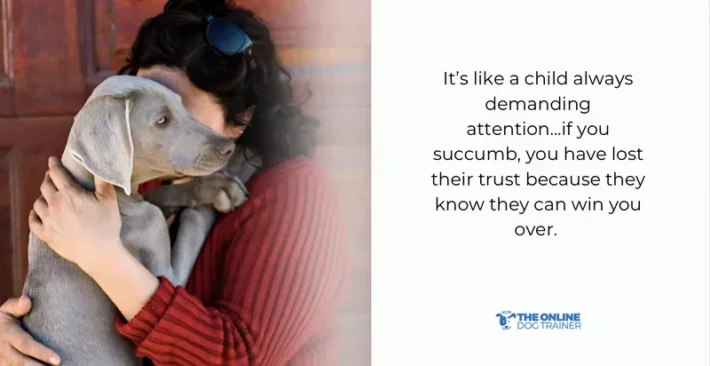
Now, I know this might sound harsh to any loving parent and dog owner. But this rule is necessary in establishing leadership.
If your dog (or child) knows they can get you with whines and puppy eyes, they will start to thinking you’re a pushover. And it’s not good for training dogs or raising kids.
But if you don’t give in, they start to see who’s charge, and who the trusted leader really is.
Moreover, if you show that you’re not easily controlled, they’ll be looking up to you.
Showing Affection Should be Within Your Dog’s Boundaries
Affectionate interactions help create a positive and nurturing environment, promoting a sense of security, happiness, and well-being in your dog.
However, it's important to note that while affection is encouraged, it should always be provided in a way that respects the dog's individual preferences and boundaries.
Additionally, some dogs may enjoy more physical contact, while others may prefer less.
So it's crucial to observe your dog's body language and respond accordingly. This ensures that the affectionate gestures are comfortable and enjoyable for them.
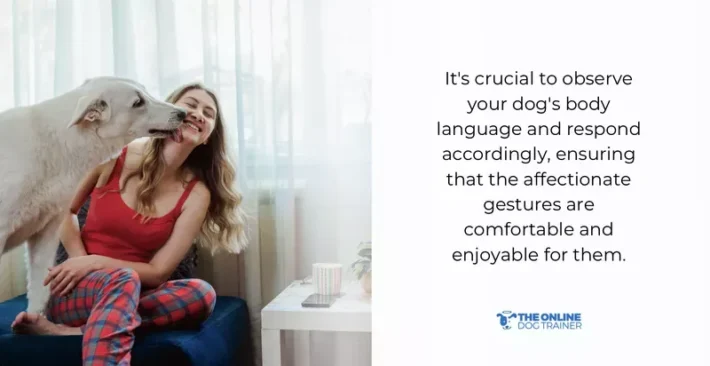
By combining affection with effective leadership, you can create a harmonious balance that fosters a strong emotional bond, trust, and mutual respect between you and your dog.
8 Things to Do to Help Dogs with Their Emotional Health
As responsible dog owners, it is crucial to acknowledge that dogs possess a remarkable ability to understand and absorb emotions and energy.
With this awareness, we must remember that we truly impact our dogs’ emotional and mental well being.
Here are seven ways we can help our dogs mentally and emotionally.
1. Create a Safe and Calming Environment
Ensure your dog has a designated space where they can retreat and feel safe.
Protect dog quality time
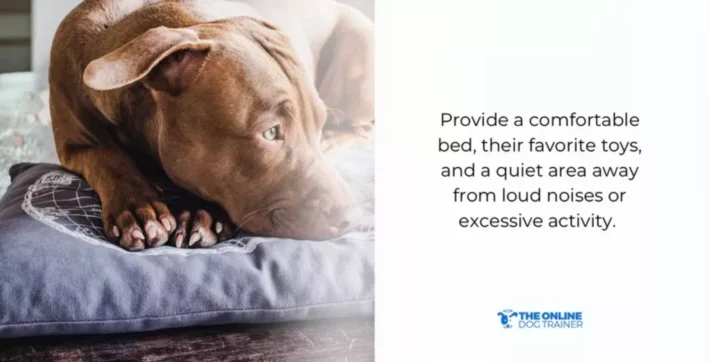
This safe haven allows them to relax and recharge, promoting emotional well-being.
2. Be Mindful of the Stress and Energy Levels in the Home
Dogs absorb energy and emotions, so imagine what could happen if there’s constant high stress and toxic emotions in the home.
Being mindful of the stress and energy levels in the home is crucial for maintaining a healthy environment for your dog.
Discover the powerful, force-free method that’s helped over 100,000 dog owners finally fix reactivity—
3. Tap Into the Power of Nature Walks
Embracing the power of nature walks can significantly benefit the emotional well-being of dogs and humans alike.
Through regular walks in natural settings, dogs can release pent-up emotional stress, enjoy sensory exploration, and engage in physical exercise.
These walks foster mental and physical health, while strengthening the bond between us and our beloved four-legged companions.
4. Socialize in a Controlled Environment
Socialization is crucial for a dog's emotional well-being, but it's essential to expose them to new experiences gradually and in a controlled manner.
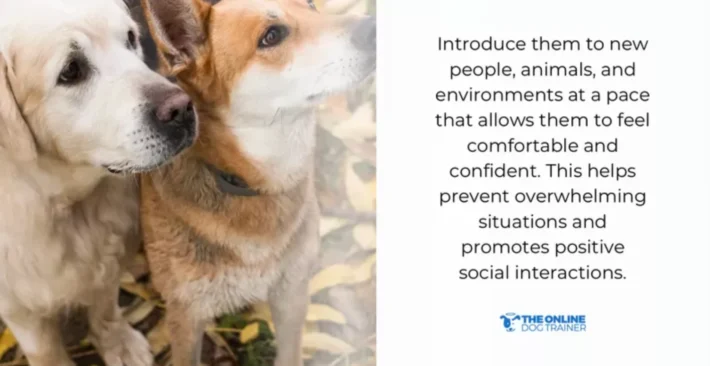
Introduce them to new people, animals, and environments at a pace that allows them to feel comfortable and confident. This helps prevent overwhelming situations.
Moreover, it promotes positive social interactions.
5. Provide Mental Stimulation
Engage your dog's mind through interactive toys, puzzle games, and training exercises.
Mental stimulation for dogs helps alleviate boredom and promotes a sense of accomplishment, boosting their emotional health.
Incorporate new activities regularly to keep their minds sharp and engaged.
6. Practice Mindful Handling
Handle your dog with care and respect.
Be aware of their body language and respond appropriately to their signals of discomfort or stress.
Gentle handling and positive experiences during grooming, vet visits, and other forms of physical contact help maintain their emotional well-being and prevent traumatic associations.
Moreover, once they feel you’re relaxed, they can relax, too.
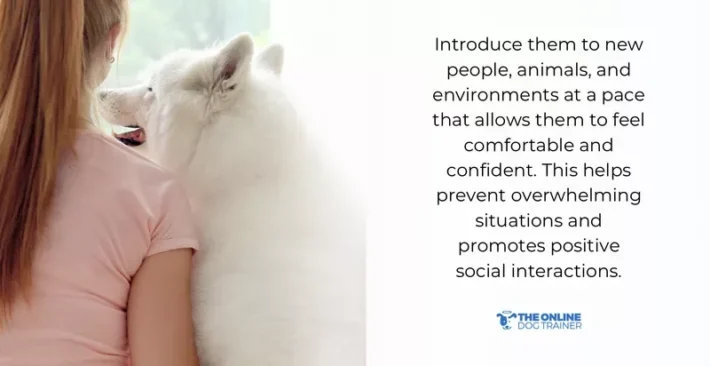
7. Be Mindful of Your Own Emotional and Mental Well-Being
Recognize that dogs absorb and understand human emotions, so you can also guard your emotions and energy.
Avoid exposing your dog to intense or negative emotions, as they can easily pick up on them.
Create a positive and harmonious atmosphere at home, and provide opportunities for relaxation, play, and bonding to enhance their emotional health.
8. Start Living The Dog Calming Code
By embracing dog ownership that radiates calm energy, positive reinforcement, and clear communication, the code helps dogs feel secure and reduces anxiety.
With the Dog Calming Code, you can foster trust and strengthen the bond between dog and you. Additionally, you can have enough tools to address behavioral issues effectively.
Moreover, this holistic program creates a nurturing environment, allowing dogs to thrive emotionally and lead balanced, fulfilling lives.
Can Dogs Understand Humans: Yes, They Do. All The More Reason To Connect and Communicate With Them In a Healthy, Healing Way
When we communicate with our dogs in a healthy and healing way, we open up channels of trust and compassion.
We become attuned to their needs, respond better to their emotions, and able to provide the love and comfort they seek.
This reciprocal exchange of understanding and affection strengthens the bond between us and creates a foundation for emotional healing.
Let us cherish this remarkable connection with our dogs and approach it with love, empathy, and respect. So when we talk to them, we are sure that they get us.
By connecting and communicating with them in a healthy, healing way, we can bring joy, comfort, and a sense of emotional well-being to both their lives and ours.

~Doggy Dan 🙂






